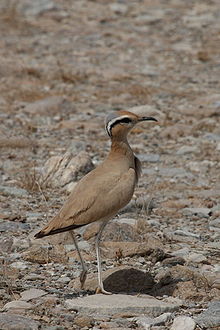- Cream-coloured Courser
-
Cream-coloured Courser 
Dibba, United Arab Emirates Conservation status Scientific classification Kingdom: Animalia Phylum: Chordata Class: Aves Order: Charadriiformes Family: Glareolidae Genus: Cursorius Species: C. cursor Binomial name Cursorius cursor
Latham, 1787The Cream-colored Courser, Cursorius cursor, is a wader in the pratincole and courser family, Glareolidae.
Although classed as waders, these are birds of dry open country, preferably semi-desert, where they typically hunt their insect prey by running on the ground.
These coursers are found in Canary Islands, north Africa and southwest Asia. Their two eggs are laid in a ground scrape. They are partially migratory, with northern and northwestern birds wintering in India, Arabia and across the southern edge of the Sahara. Some birds also breed in the southern desert regions in northwestern India and Pakistan.[1]
They are rare north of the breeding range, but this species has occurred as far away as Finland, Ireland and Great Britain.
These birds have long legs and long wings. They have slightly downcurved bills. The body plumage is sandy in colour, fading to whitish on the lower belly. The upperwing primary feathers and the underwings are black. The crown and nape are grey, and there is a black eyestripe and white supercilium.
In flight this species resembles a pratincole, with its relaxed wingbeats, pointed wings and dark underwings.
Reference and taxonomic note
Shorebirds by Hayman, Marchant and Prater ISBN 0-7099-2034-2
This standard text treats the east African form littoralis as a race of the Somali Courser rather than of Cream-colored. Some authorities in turn consider the Somali, Burchell's and Cream-colored coursers to be conspecific.
References
- ^ Rahmani,Asad R; Manakadan,Ranjit (1989): Breeding records of Creamcoloured Courser Cursorius cursor cursor (Latham) from India. J. Bombay Nat. Hist. Soc. 86(3), 447-448.
- BirdLife International (2004). Cursorius cursor. 2006. IUCN Red List of Threatened Species. IUCN 2006. www.iucnredlist.org. Retrieved on 11 May 2006. Database entry includes justification for why this species is of least concern
External links
- Oiseaux Photos

This Charadriiformes-related article is a stub. You can help Wikipedia by expanding it.

